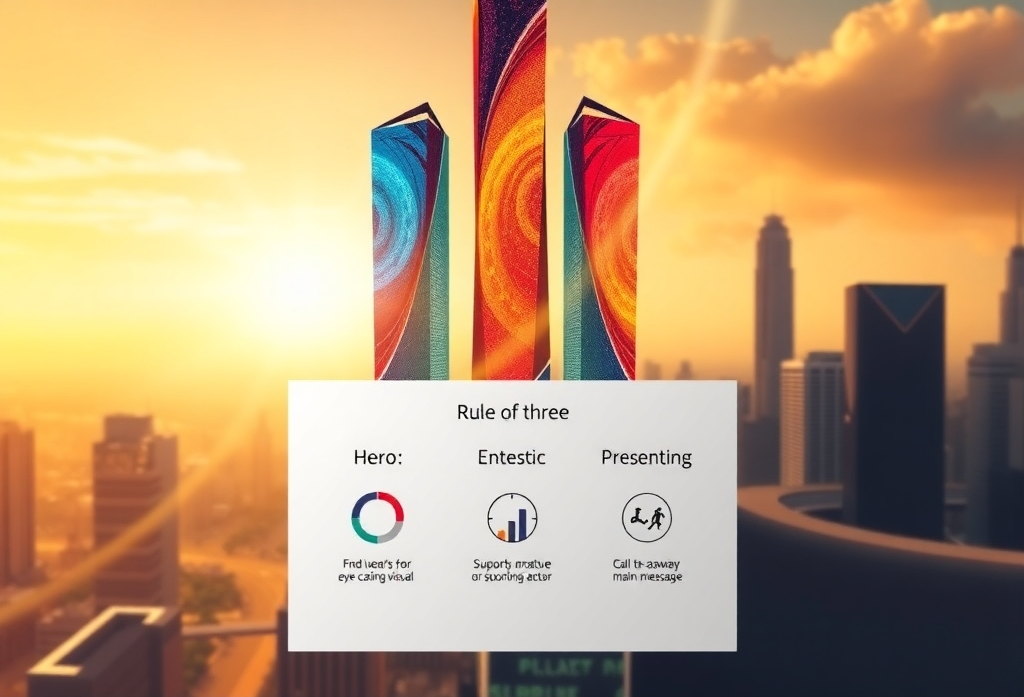Have you ever wondered why some presentations stick in your memory while others fade away before you’ve even left the room? Why certain speakers seem to effortlessly convey complex ideas while others leave you drowning in information overload? The answer might be simpler than you think – and it’s been hiding in plain sight for thousands of years.
Enter the Rule of Three, perhaps the most powerful yet underutilized principle in presentation design. It’s a concept so deeply ingrained in human psychology that we barely notice its influence, yet so effective that it shapes everything from fairy tales to political speeches to the world’s most memorable advertising campaigns.
The Magic Number in Our Minds
Our brains have a peculiar relationship with the number three. It’s the smallest number required to create a pattern, yet still small enough to be easily processed and remembered. Three is the sweet spot between “not enough information” and “too much to handle.”
Don’t believe me? Let’s look at the evidence:
Stories have beginnings, middles, and ends. Jokes have setups, anticipation, and punchlines. Time exists in past, present, and future. Even our finest meals are structured as appetizers, main courses, and desserts.
This isn’t coincidence – it’s cognitive architecture.
The Ancient Roots of the Rule of Three
The Rule of Three isn’t some modern presentation hack. Aristotle identified it in his work on rhetoric over 2,000 years ago, noting that three creates a sense of completeness and satisfaction. The ancient Romans codified it in the Latin phrase “omne trium perfectum” – everything that comes in threes is perfect.
From Julius Caesar’s “Veni, vidi, vici” (I came, I saw, I conquered) to the Declaration of Independence’s “life, liberty, and the pursuit of happiness,” history’s most memorable phrases often come in threes.
How the Rule of Three Transforms Presentations
So how does this ancient principle apply to your next quarterly review or product pitch? Let me count the ways (and yes, there are three of them):
1. Structural Clarity
The most effective presentations follow a three-part structure:
- Introduction (Tell them what you’re going to tell them)
- Body (Tell them)
- Conclusion (Tell them what you told them)
This structure provides a natural narrative arc that guides your audience through your content. It creates anticipation, delivers substance, and reinforces key messages – all while feeling intuitively “right” to your audience.
When you break from this structure, audiences often feel disoriented, even if they can’t articulate why. Their brains are wired to expect this pattern, and deviating from it creates cognitive dissonance.
2. Information Retention
Research consistently shows that people remember information better when it’s presented in groups of three. When faced with a list of items, we tend to remember the first item (primacy effect) and the last item (recency effect). By limiting your key points to three, you maximize the chances that your entire message will be retained.
Consider these examples:
- “Our solution is faster, cheaper, and more reliable.”
- “This approach will benefit our customers, our employees, and our bottom line.”
- “We need to focus on innovation, efficiency, and customer satisfaction.”
Each of these statements is easily digestible and memorable because it follows the Rule of Three. Contrast this with a statement like “Our solution is faster, cheaper, more reliable, more intuitive, and has better customer support” – by the time you reach the end, your audience has forgotten the beginning.
3. Rhetorical Power
The Rule of Three creates a powerful rhythm in spoken language. It builds momentum, creates emphasis, and delivers satisfaction when the final element is reached.
This technique, known as a “tricolon” in rhetoric, appears in countless famous speeches:
- “Government of the people, by the people, for the people” (Lincoln)
- “Read my lips: no new taxes” (Bush)
- “Education, education, education” (Blair)
Even in everyday presentations, grouping ideas in threes creates a sense of completeness and finality that two elements lack and four elements dilute.
Implementing the Rule of Three in Your Presentations
Now that we understand why the Rule of Three works, let’s talk about how to apply it:
For overall structure: Divide your presentation into three main sections. Even if you have more content to cover, find ways to group it into three overarching categories. This creates a mental framework that helps your audience organize and retain information.
For key messages: Identify the three most important points you want your audience to remember. These should be your north stars throughout the presentation. If something doesn’t support one of these three points, consider whether it belongs in your presentation at all.
For slide design: When creating visual layouts, arrange elements in groups of three when possible. This creates balance and visual harmony. Three columns, three icons, or three examples feel complete and satisfying to the eye.
For verbal delivery: Practice expressing complex ideas in groups of three. This often requires distilling your thinking to its essence, which is a valuable exercise in itself. The discipline of the Rule of Three forces clarity and concision.
When to Break the Rule
Like all rules, the Rule of Three has its exceptions. Sometimes two points are truly sufficient (compare and contrast), and occasionally a topic genuinely requires four or five key elements to be fully understood.
However, even in these cases, consider whether you can create hierarchies within your information. Perhaps your five points can be organized into three categories, or your seven steps can be grouped into three phases.
The goal isn’t rigid adherence to a formula, but rather leveraging the natural power of three to enhance understanding and retention.
Conclusion: The Rule of Three in Action
The beauty of the Rule of Three is its versatility. It works equally well for high-stakes keynotes and impromptu team updates. It scales from three-word phrases to three-day conferences.
By structuring your presentations around this principle, you’re not just following an arbitrary rule – you’re aligning your communication with the way human minds naturally process information. You’re creating rhythm, balance, and momentum that makes your ideas more persuasive and memorable.
So the next time you’re preparing a presentation, remember: the Rule of Three isn’t just an ancient principle – it’s cognitively optimized design. It’s simplicity with strategic intent. It’s the difference between a presentation that fades and one that resonates.
And those three reasons are more than enough to give it a try.
Paul Mansfield is a PowerPoint designer with over 30 years of experience transforming corporate presentations from boring to brilliant. He believes that great presentations are equal parts art, science, and psychology. Learn more at paulmansfield.net




